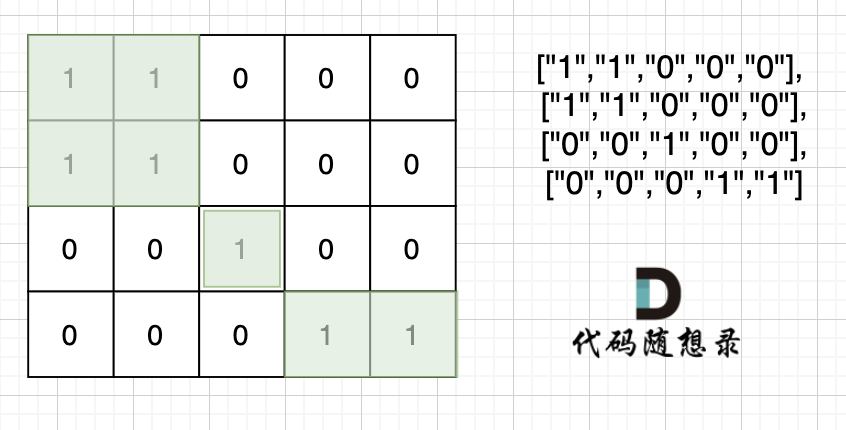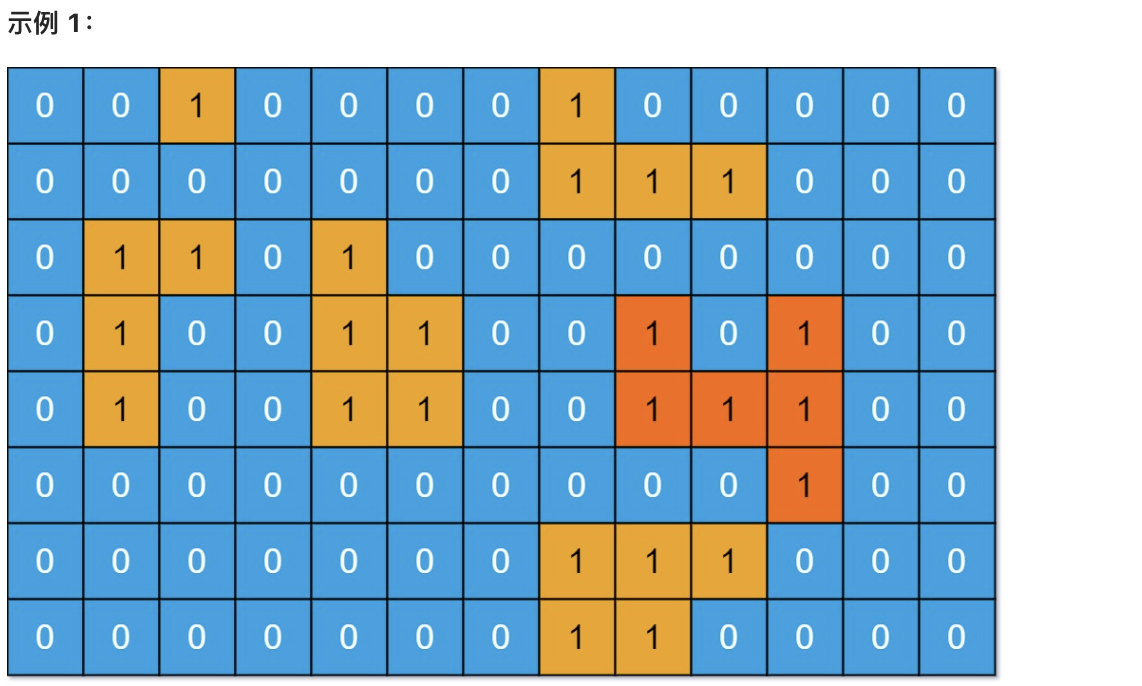島嶼數量
題目描述
力扣200-島嶼數量
給你一個由 '1'(陸地)和 '0'(水)組成的的二維網格,請你計算網格中島嶼的數量。
島嶼總是被水包圍,并且每座島嶼只能由水平方向和/或豎直方向上相鄰的陸地連接形成。
此外,你可以假設該網格的四條邊均被水包圍。
示例 2:
輸入:grid = [["1","1","0","0","0"],["1","1","0","0","0"],["0","0","1","0","0"],["0","0","0","1","1"]
]
輸出:3

本題思路,是用遇到一個沒有遍歷過的節點陸地,計數器就加一,然后把該節點陸地所能遍歷到的陸地都標記上。在遇到標記過的陸地節點和海洋節點的時候直接跳過。 這樣計數器就是最終島嶼的數量。
那么如果把節點陸地所能遍歷到的陸地都標記上呢,就可以使用 DFS,BFS或者并查集。
廣度優先搜索 BFS
不少同學用廣搜做這道題目的時候,超時了。 這里有一個廣搜中很重要的細節:
根本原因是==只要 加入隊列就代表 走過,就需要標記,而不是從隊列拿出來的時候再去標記走過==。
很多同學可能感覺這有區別嗎?
如果從隊列拿出節點,再去標記這個節點走過,就會發生下圖所示的結果,會導致很多節點重復加入隊列。

`visited[x][y] = true;` 放在的地方,著去取決于我們對 代碼中隊列的定義,隊列中的節點就表示已經走過的節點。 **所以只要加入隊列,立即標記該節點走過**。
本題完整廣搜代碼:
class Solution {private static final int[][] dir = { { 0, 1 }, { 1, 0 }, { -1, 0 }, { 0, -1 } }; // 四個方向private void bfs(char[][] grid, boolean[][] visited, int x, int y) {//用于將當前陸地相連的陸地都進行標記Queue<int[]> queue = new LinkedList<>();queue.add(new int[] { x, y });visited[x][y] = true; // 只要加入隊列,立刻標記while (!queue.isEmpty()) {int[] cur = queue.poll();int curx = cur[0];// 取出當前節點(curx,cury)int cury = cur[1];// 遍歷四個方向,如果相鄰節點(nextx,nexty)在網格內切未被訪問過,并且其是陸地(1),則將其加入到隊列,并將其標記為已訪問for (int[] d : dir) {int nextx = curx + d[0];int nexty = cury + d[1];if (nextx < 0 || nextx >= grid.length || nexty < 0 || nexty >= grid[0].length)continue; // 越界了,直接跳過if (!visited[nextx][nexty] && grid[nextx][nexty] == '1') {queue.add(new int[] { nextx, nexty });visited[nextx][nexty] = true; // 只要加入隊列立刻標記}}} // 循環直到隊列為空,即所有與起始點連通的陸地都被標記為已訪問}public int numIslands(char[][] grid) {int n = grid.length;int m = grid[0].length;boolean[][] visited = new boolean[n][m];// 二維布爾數組visited,用于標記網格中每個位置是否已被訪問過int result = 0;for (int i = 0; i < n; i++) {for (int j = 0; j < m; j++) {if (!visited[i][j] && grid[i][j] == '1') {// 當前位置 未訪問過的且是陸地,島嶼數量+1result++; // 遇到沒訪問過的陸地,+1bfs(grid, visited, i, j); // 將與其鏈接的陸地都標記上 true}}}return result;}
}深度優先搜索 DFS—模板
//DFS
class Solution {private int[][] dir = {{0, 1}, {1, 0}, {-1, 0}, {0, -1}}; // 四個方向private void dfs(char[][] grid, boolean[][] visited, int x, int y) {for (int[] d : dir) {int nextx = x + d[0];int nexty = y + d[1];if (nextx < 0 || nextx >= grid.length || nexty < 0 || nexty >= grid[0].length) continue; // 越界了,直接跳過if (!visited[nextx][nexty] && grid[nextx][nexty] == '1') { // 沒有訪問過的同時是陸地的visited[nextx][nexty] = true; dfs(grid, visited, nextx, nexty);} }}public int numIslands(char[][] grid) {int n = grid.length;int m = grid[0].length;boolean[][] visited = new boolean[n][m];int result = 0;for (int i = 0; i < n; i++) {for (int j = 0; j < m; j++) {if (!visited[i][j] && grid[i][j] == '1') { visited[i][j] = true;result++; // 遇到沒訪問過的陸地,+1dfs(grid, visited, i, j); // 將與其鏈接的陸地都標記上 true}}}return result;}
}下面的代碼使用的是深度優先搜索 DFS 的做法。為了統計島嶼數量同時不重復記錄,每當我們搜索到一個島后,就將這個島 “淹沒” —— 將這個島所占的地方從 “1” 改為 “0”,這樣就不用擔心后續會重復記錄這個島嶼了。而 DFS 的過程就體現在 “淹沒” 這一步中。詳見代碼:
public int numIslands(char[][] grid) {int res = 0; //記錄找到的島嶼數量for(int i = 0;i < grid.length;i++){for(int j = 0;j < grid[0].length;j++){//找到“1”,res加一,同時淹沒這個島if(grid[i][j] == '1'){res++;dfs(grid,i,j);}}}return res;
}
//使用DFS“淹沒”島嶼
public void dfs(char[][] grid, int i, int j){//搜索邊界:索引越界或遍歷到了"0"if(i < 0 || i >= grid.length || j < 0 || j >= grid[0].length || grid[i][j] == '0') return;//將這塊土地標記為"0"grid[i][j] = '0';//根據"每座島嶼只能由水平方向或豎直方向上相鄰的陸地連接形成",對上下左右的相鄰頂點進行dfsdfs(grid,i - 1,j);dfs(grid,i + 1,j);dfs(grid,i,j + 1);dfs(grid,i,j - 1);
}
島嶼的最大面積
題目描述
力扣695-島嶼的最大面積
給你一個大小為 m x n 的二進制矩陣 grid 。
島嶼 是由一些相鄰的 1 (代表土地) 構成的組合,這里的「相鄰」要求兩個 1 必須在 水平或者豎直的四個方向上 相鄰(斜角度的不算)。你可以假設 grid 的四個邊緣都被 0(代表水)包圍著。
島嶼的面積是島上值為 1 的單元格的數目。
計算并返回 grid 中最大的島嶼面積。如果沒有島嶼,則返回面積為 0 。
示例 1:

輸入:grid = [[0,0,1,0,0,0,0,1,0,0,0,0,0],[0,0,0,0,0,0,0,1,1,1,0,0,0],[0,1,1,0,1,0,0,0,0,0,0,0,0],[0,1,0,0,1,1,0,0,1,0,1,0,0],[0,1,0,0,1,1,0,0,1,1,1,0,0],[0,0,0,0,0,0,0,0,0,0,1,0,0],[0,0,0,0,0,0,0,1,1,1,0,0,0],[0,0,0,0,0,0,0,1,1,0,0,0,0]]
輸出:6
解釋:答案不應該是 11 ,因為島嶼只能包含水平或垂直這四個方向上的 1 。
示例 2:
輸入:grid = [[0,0,0,0,0,0,0,0]]
輸出:0
解題思路
這道題目也是 dfs bfs基礎類題目,就是搜索每個島嶼上“1”的數量,然后取一個最大的。
本題思路上比較簡單,難點其實都是 dfs 和 bfs的理論基礎,關于理論基礎我在這里都有詳細講解 :
DFS理論基礎(opens new window)
BFS理論基礎
根據BFS模板
//BFS
class Solution {private int[][] dir = {{0, 1}, {1, 0}, {-1, 0}, {0, -1}}; // 表示四個方向void bfs(char[][] grid, boolean[][] visited, int x, int y) {Queue<int[]> queue = new LinkedList<>(); // 定義隊列queue.offer(new int[]{x, y}); // 起始節點加入隊列visited[x][y] = true; // 只要加入隊列,立刻標記為訪問過的節點while (!queue.isEmpty()) { // 開始遍歷隊列里的元素int[] cur = queue.poll(); // 從隊列取元素int curx = cur[0];int cury = cur[1]; // 當前節點坐標for (int i = 0; i < 4; i++) { // 開始向當前節點的四個方向左右上下去遍歷int nextx = curx + dir[i][0];int nexty = cury + dir[i][1]; // 獲取周圍四個方向的坐標if (nextx < 0 || nextx >= grid.length || nexty < 0 || nexty >= grid[0].length) continue; // 坐標越界了,直接跳過if (!visited[nextx][nexty]) { // 如果節點沒被訪問過queue.offer(new int[]{nextx, nexty}); // 隊列添加該節點為下一輪要遍歷的節點visited[nextx][nexty] = true; // 只要加入隊列立刻標記,避免重復訪問}}}}
}BFS
//BFS
class Solution {int[][] dir = {{ 0, 1 }, { 1, 0 }, { 0, -1 }, { -1, 0 }};int count;boolean visited[][];public int maxAreaOfIsland(int[][] grid) {int res = 0;visited = new boolean[grid.length][grid[0].length];for (int i = 0; i < grid.length; i++) {for (int j = 0; j < grid[0].length; j++) {if (visited[i][j] == false && grid[i][j] == 1) {count = 0;bfs(grid, i, j);res = Math.max(res, count);}}}return res;}private void bfs(int[][] grid, int x, int y) {Queue<int[]> queue = new LinkedList<>(); // 定義隊列queue.offer(new int[] { x, y }); // 起始節點加入隊列visited[x][y] = true; // 只要加入隊列,立刻標記為訪問過的節點count++; // 將起始節點也算入島嶼面積中while (!queue.isEmpty()) { // 開始遍歷隊列里的元素int[] cur = queue.poll(); // 從隊列取元素int curx = cur[0];int cury = cur[1]; // 當前節點坐標for (int i = 0; i < 4; i++) { // 開始向當前節點的四個方向左右上下去遍歷int nextx = curx + dir[i][0];int nexty = cury + dir[i][1]; // 獲取周圍四個方向的坐標if (nextx < 0 || nextx >= grid.length || nexty < 0 || nexty >= grid[0].length)continue;if (visited[nextx][nexty] == false && grid[nextx][nexty] == 1) {queue.offer(new int[] { nextx, nexty }); // 隊列添加該節點為下一輪要遍歷的節點visited[nextx][nexty] = true;count++;}}}}}
根據DFS模板
//DFS
class Solution {private int[][] dir = {{0, 1}, {1, 0}, {-1, 0}, {0, -1}}; // 四個方向private void dfs(char[][] grid, boolean[][] visited, int x, int y) {for (int[] d : dir) {int nextx = x + d[0];int nexty = y + d[1];if (nextx < 0 || nextx >= grid.length || nexty < 0 || nexty >= grid[0].length) continue; // 越界了,直接跳過if (!visited[nextx][nexty] && grid[nextx][nexty] == '1') { // 沒有訪問過的同時是陸地的visited[nextx][nexty] = true; dfs(grid, visited, nextx, nexty);} }}public int numIslands(char[][] grid) {int n = grid.length;int m = grid[0].length;boolean[][] visited = new boolean[n][m];int result = 0;for (int i = 0; i < n; i++) {for (int j = 0; j < m; j++) {if (!visited[i][j] && grid[i][j] == '1') { visited[i][j] = true;result++; // 遇到沒訪問過的陸地,+1dfs(grid, visited, i, j); // 將與其鏈接的陸地都標記上 true}}}return result;}
}DFS
//DFS
class Solution {private int count;private int[][] dir = { { 0, 1 }, { 1, 0 }, { -1, 0 }, { 0, -1 } }; // 四個方向private void dfs(int[][] grid, boolean[][] visited, int x, int y) {for (int[] d : dir) {int nextx = x + d[0];int nexty = y + d[1];if (nextx < 0 || nextx >= grid.length || nexty < 0 || nexty >= grid[0].length)continue; // 越界了,直接跳過if (!visited[nextx][nexty] && grid[nextx][nexty] == 1) { // 沒有訪問過的 同時 是陸地的visited[nextx][nexty] = true;count++;dfs(grid, visited, nextx, nexty);}}}public int maxAreaOfIsland(int[][] grid) {int n = grid.length;int m = grid[0].length;boolean[][] visited = new boolean[n][m];int result = 0;for (int i = 0; i < n; i++) {for (int j = 0; j < m; j++) {if (!visited[i][j] && grid[i][j] == 1) {count = 1; // 因為dfs處理下一個節點,所以這里遇到陸地了就先計數,dfs處理接下來的相鄰陸地visited[i][j] = true;dfs(grid, visited, i, j); // 將與其鏈接的陸地都標記上 trueresult = Math.max(result, count);}}}return result;}
}ps:部分圖片和代碼來自代碼隨想錄和Leetcode官網

優化RF隨機森林結合Adaboost分類預測(二分類及多分類))








![[數據結構] 基于交換的排序 冒泡排序快速排序](http://pic.xiahunao.cn/[數據結構] 基于交換的排序 冒泡排序快速排序)





)


